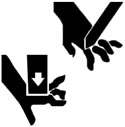 The primary function of all guarding is to prevent an operator or bystander from being injured by a potentially dangerous portion of a machine. Often the hazard involves moving parts with the potential to cut, crush or draw-in body parts, although barrier guards may also be necessary when electrical, thermal or chemical dangers are present. Guarding may be accomplished with simple physical shielding of machine parts, or more advanced techniques such as laser curtains. It is also often necessary to employ interlocks to disable power to the machine when a guard has been removed.
The primary function of all guarding is to prevent an operator or bystander from being injured by a potentially dangerous portion of a machine. Often the hazard involves moving parts with the potential to cut, crush or draw-in body parts, although barrier guards may also be necessary when electrical, thermal or chemical dangers are present. Guarding may be accomplished with simple physical shielding of machine parts, or more advanced techniques such as laser curtains. It is also often necessary to employ interlocks to disable power to the machine when a guard has been removed.
Expertise
We have extensive experience evaluating proper machine guard design and methods including:
- Interlock design and implementation
- Familiarization with guarding standards and effective warning design
- Punch press pullbacks
- Roller and nip-point guarding
Questions Answered
Through scientific analysis, we can help you answer pertinent questions such as:
- Did the machine operator circumvent the guarding?
- Were the pullbacks damaged or improperly adjusted?
- Could a proper interlock have prevented this accident?
- Were the machine's warnings adequate?
Case Examples
Damaged Pullback Hand Injury:
A machinist working on a press equipped with a pullback device suffered a crushed hand when it was caught in the point of operation. After inspecting the pullbacks, it was determined that one of the cable guide-tubes had been damaged. The damage allowed the pullback settings to be different for each hand. When the foreman set the pullbacks, he only tested the undamaged one. Thus, the damaged pullback permitted his other hand to remain at the point of operation and to be crushed by the ram.
Stone Screening Conveyor Belt Accident:
A worker at a stone-screening site attempted to service a conveyor belt while the screener was in operation. His sleeve became caught in the belt's tail pulley drawing him in and causing him to lose his arm. Prior to trial we determined that the locked door that contained the tail pulley was an appropriate guard and that the hostile environment would not permit an effective interlock. Thus, the worker was entirely at fault in this instance and was willing to accept a reduced settlement.
Kristopher J. Seluga, PE, is a Mechanical Engineering, Accident Reconstruction, Biomechanics, and Safety Expert with over 20 years of experience. He received his Bachelor's and Master's degrees from the Mechanical Engineering department at MIT where he worked on the development of novel three-dimensional printing technologies. Mr. Seluga is also a licensed Professional Engineer in New York and Connecticut, and has served as a member of the ANSI engineering committee for the Z130.1 and Z135 standards for golf cars and PTV's. His research interests and peer reviewed publications span the topics of Motor Vehicle Dynamics, Product Safety, and Biomechanics.
©Copyright - All Rights Reserved
DO NOT REPRODUCE WITHOUT WRITTEN PERMISSION BY AUTHOR.



 The primary function of all guarding is to prevent an operator or bystander from being injured by a potentially dangerous portion of a machine. Often the hazard involves moving parts with the potential to cut, crush or draw-in body parts, although barrier guards may also be necessary when electrical, thermal or chemical dangers are present. Guarding may be accomplished with simple physical shielding of machine parts, or more advanced techniques such as laser curtains. It is also often necessary to employ interlocks to disable power to the machine when a guard has been removed.
The primary function of all guarding is to prevent an operator or bystander from being injured by a potentially dangerous portion of a machine. Often the hazard involves moving parts with the potential to cut, crush or draw-in body parts, although barrier guards may also be necessary when electrical, thermal or chemical dangers are present. Guarding may be accomplished with simple physical shielding of machine parts, or more advanced techniques such as laser curtains. It is also often necessary to employ interlocks to disable power to the machine when a guard has been removed.






